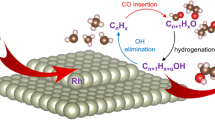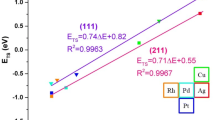Abstract
Production of higher alcohols directly from synthesis gas is an attractive chemical process due to the high value of alcohols as fuel blends and the numerous possibilities for production of synthesis gas. Despite years of research the industrial viability of such a process is severely limited due to lack of suitable catalysts. In this work we contribute to an understanding why it has been difficult to find transition-metal higher alcohol catalysts, and point to possible strategies for discovering new active and selective catalysts. Our analysis is based on extensive density functional theory calculations to determine the energetics of ethanol formation on a series of metal (211) surfaces. The energetic information is used to construct a mean-field micro-kinetic model for the formation of ethanol via CHx–CO coupling. The kinetic model is used along with a descriptor-based analysis to gain insight into the fundamental factors determining activity and selectivity on transition-metal surfaces.




Similar content being viewed by others
References
Spath PL, Dayton DC (2003) Preliminary screening—technical and economic assessment of synthesis gas to fuels and chemicals with emphasis on the potential for biomass-derived syngas; NREL/TP-510-34929. Golden, National Renewable Energy Laboratory
Spivey JJ, Egbebi A (2007) Heterogeneous catalytic synthesis of ethanol from biomass-derived syngas. Chem Soc Rev 36:1514–1528
Subramani V, Gangwal SK (2008) A review of recent literature to search for an efficient catalytic process for the conversion of syngas to ethanol. Energy Fuels 22:814–839
Surisetty VR, Dalai AK, Kozinski J (2011) Alcohols as alternative fuels: an overview. Appl Catal A 404:1–11
Nunan JG, Bogdan CE, Klier K, Smith KJ, Young C-W, Herman RG (1989) Higher alcohol and oxygenate synthesis over cesium-doped Cu/ZnO catalysts. J Catal 116:195–221
Xu M, Iglesia E (1999) Carbon-carbon bond formation pathways in CO hydrogenation to higher alcohols. J Catal 188:125–131
Gupta M, Smith ML, Spivey JJ (2011) Heterogeneous catalytic conversion of dry syngas to ethanol and higher alcohols on Cu-based catalysts. ACS Catal 1:641–656
Matsuzaki T, Takeuchi K, Hanaoka TA, Arawaka H, Sugi Y (1993) Effect of transition metals on oxygenates formation from syngas over Co/SiO2. Appl Catal A 105:159–184
Ichikawa M (1978) Catalytic synthesis of ethanol from CO and H2 under atmospheric pressure over pyrolysed rhodium carbonyl clusters on TiO2, ZrO2, and La2O3. J Chem Soc, Chem Commun 566–567
Bhasin MM, Bartley WJ, Ellgen PC, Wilson TP (1978) Synthesis gas conversion over supported rhodium and rhodium-iron catalysts. J Catal 54:120–128
Courty P, Durand D, Freund E, Sugier A (1982) C1–C6 alcohols from synthesis gas on copper–cobalt catalysts. J Mol Catal 17:241–254
Subramanian N, Gao J, Mo X, Goodwin J, Torres W, Spivey JJ (2010) La and/or V oxide promoted Rh/SiO2 catalysts: effect of temperature, H2/CO ratio, space velocity, and pressure on ethanol selectivity from syngas. J Catal 262:204–209
Murchison CB, Conway MM, Stevens RR, Quarderer GJ (1988) Mixed alcohols from syngas over moly catalysts. In: Ternan M (ed) Proceedings of the 9th international congress of catalysis; Phillips. Chemical Institute of Canada, Ottawa, pp 626–633
Woo HC, Park KY, Kim YG, Nam IS, Chung JS, Lee JS (1991) Mixed alcohol synthesis from carbon monoxide and dihydrogen over potassium promoted molybdenum carbide catalysts. Appl Catal 75:267–280
Christensen JM, Duchstein LDL, Wagner JB, Jensen PA, Temel B, Jensen AD (2012) Catalytic conversion of syngas into higher alcohols over carbide catalysts. Ind Eng Chem Res 51:4161–4172
Mei D, Rosseau R, Kathmann SM, Glezakou VA, Engelhard MH, Jiang W, Wang C, Gerber MA, White JF, Stevens DJ (2010) Ethanol synthesis from syngas over Rh-based/SiO2 catalysts: a combined experimental and theoretical modeling study. J Catal 271:325–342
Choi Y, Liu P (2009) Mechanism of ethanol synthesis from syngas on Rh(111). J Am Chem Soc 131:13054–13061
Ferrin P, Simonetti D, Kandoi S, Kunkes E, Dumesic J, Nørskov J, Mavrikakis M (2009) Modeling ethanol decomposition on transition metals: a combined application of scaling and Brønsted–Evans–Polanyi relations. J Am Chem Soc 131:5809–5815
The Dacapo plane wave/pseudopotential code is available as opensource software at http://wiki.fysik.dtu.dk/dacapo
Hammer B, Hansen LB, Nørskov JK (1999) Improved adsorption energetics within density-functional theory using revised Perdew–Burke–Ernzerhof functionals. Phys Rev B 59:7413–7421
Lausche AC, Medford AJ, Khan TS, Xu Y, Bligaard T, Abild-Pedersen F, Nørskov JK, Studt F (2013) On the effect of coverage-dependent adsorbate–adsorbate interactions for CO methanation on transition metal surfaces. J Catal 307:275–282
Studt F, Abild-Pedersen F, Wu Q, Jensen AD, Temel B, Grunwaldt JD, Nørskov JK (2012) CO hydrogenation to methanol on Cu–Ni catalysts: theory and experiment. J Catal 293:51–60
Wang S, Temel B, Shen J, Jones G, Grabow LC, Studt F, Bligaard T, Abild-Pedersen F, Christensen CH, Nørskov JK (2011) Universal Brønsted–Evans–Polanyi relations for C–C, C–O, C–N, N–O, N–N, and O–O dissociation reactions. Catal Lett 141:370–373
Wang S, Petzold V, Tripkovic V, Kleis J, Howalt JG, Skúlason E, Fernández EM, Hvolbæk B, Jones G, Toftelund A, Falsig H, Björketun M, Studt F, Abild-Pedersen F, Rossmeisl J, Nørskov JK, Bligaard T (2011) Universal transition state scaling relations for (de)hydrogenation over transition metals. Phys Chem Chem Phys 13:20760–20765
Hummelshøj JS, Abild-Pedersen F, Studt F, Bligaard T, Nørskov JK (2012) CatApp: a web application for surface chemistry and heterogeneous catalysis. Angew Chem Int Ed 51:272–274
Monkhorst HJ, Pack JD (1976) Special points for Brillouin-zone integrations. Phys Rev B 13:5188–5192
Andersson MP, Abild-Pedersen F, Remediakis IN, Bligaard T, Jones G, Engbæk J, Lytken O, Horch S, Nielsen JH, Sehested J, Rostrup-Nielsen JR, Nørskov JK, Chorkendorff I (2008) Structure sensitivity of the methanation reaction: H2-induced CO dissociation on nickel surfaces. J Catal 255:6–19
Grabow LC, Mavrikakis M (2011) Mechanism of methanol synthesis on Cu through CO2 and CO hydrogenation. ACS Catal 1:365–384
Ojeda M, Li A, Nabar R, Nilekar AU, Mavrikakis M, Iglesia E (2010) Kinetically relevant steps and H2/D2 isotope effects in Fischer–Tropsch synthesis on Fe and Co catalysts. J Phys Chem 114:19761–19770
Ojeda M, Nabar R, Nilekar AU, Ishikawa A, Mavrikakis M, Iglesia E (2010) CO activation pathways and the mechanism of Fischer–Tropsch synthesis. J Catal 272:287–297
Nørskov JK, Abild-Pedersen F, Studt F, Bligaard T (2011) Density functional theory in surface science and catalysis. Proc Natl Acad Sci USA 108:937–943
Behrens M, Studt F, Kasatkin I, Kühl S, Hävecker M, Abild-Pedersen F, Zander S, Girgsdies F, Kurr P, Kniep BJ, Tovar M, Fischer RW, Nørskov JK, Schlögl R (2012) The active site of methanol synthesis over Cu/ZnO/Al2O3 industrial catalysts. Science 336:893–897
Bligaard T, Nørskov JK, Dahl S, Matthiesen J, Christensen CH, Sehested J (2004) The Brønsted–Evans–Polanyi relation and the volcano curve in heterogeneous catalysis. J Catal 224:206–217
Abild-Pedersen F, Greeley J, Studt F, Rossmeisl J, Munter TR, Moses PG, Skúlason E, Bligaard T, Nørskov JK (2007) Scaling properties of adsorption energies for hydrogen-containing molecules on transition-metal surfaces. Phys Rev Lett 99:016105
Jones G, Studt F, Abild-Pedersen F, Nørskov JK, Bligaard T (2011) Scaling relationships for adsorption energies of C2 hydrocarbons on transition metal surfaces. Chem Eng Sci 66:6318–6323
Pallassana V, Neurock M (2000) Electronic factors governing ethylene hydrogenation and dehydrogenation activity of pseudomorphic PdML/Re(0001), PdML/Ru(0001), Pd(111), and PdML/Au(111) Surfaces. J Catal 191:301–317
Nørskov JK, Bligaard T, Logadottir A, Bahn S, Hansen LB, Bollinger M, Bengaard H, Hammer B, Sljivancanin Z, Mavrikakis M, Xu Y, Dahl S, Jacobsen CJH (2002) Universality in heterogeneous catalysis. J Catal 209:275–278
Michaelides A, Liu ZP, Zhang CJ, Alavi A, King DA, Hu P (2003) Identification of general linear relationships between activation energies and enthalpy changes for dissociation reactions at surfaces. J Am Chem Soc 125:3704–3705
Chinchen GC, Denny PJ, Parker DG, Spencer MS, Whan DA (1987) Mechanism of methanol synthesis from CO2/CO/H2 mixtures over copper/zinc oxide/alumina catalysts: use of 14C-labelled reactants. Appl Catal 30:333–338
Sahibzada M, Metcalfe IS, Chadwick D (1998) Methanol synthesis from CO/CO2/H2 over Cu/ZnO/Al2O3 at differential and finite conversions. J Catal 174:111–118
Xu R, Yang C, Wei W, Li W, Sun Y, Hu T (2004) Fe-modified CuMnZrO2 catalysts for higher alcohols synthesis from syngas. J Mol Catal A 221:51–58
Guczi L, Hoffer T, Zsoldos Z, Zyade S, Maire G, Garin F (1991) Structure and catalytic activity of alumina-supported Pt–Co bimetallic catalysts. chemisorption and catalytic reactions. J Phys Chem 95:802–808
Gnanamani MK, Ribeiro MC, Ma W, Shafer WD, Jacobs G, Graham UM, Davis BH (2011) Fischer–Tropsch synthesis: metal-support interfacial contact governs oxygenates selectivity over CeO2 supported Pt–Co catalysts. Appl Catal A 393:17–23
Jacobsen CJH, Dahl S, Clausen BS, Bahn S, Logadottir A, Nørskov JK (2001) Catalyst design by interpolation in the periodic table: bimetallic ammonia synthesis catalysts. J Am Chem Soc 123:8404
Greeley J, Nørskov JK (2005) A general scheme for the estimation of oxygen binding energies on binary transition metal surface alloys. Surf Sci 592:104–111
Mortensen JJ, Hammer B, Nørskov JK (1998) Alkali promotion of N2 dissociation over Ru(0001). Phys Rev Lett 80:4333–4336
Bengaard HS, Nørskov JK, Sehested JS, Clausen BS, Nielsen LP, Molenbroek A, Rostrup-Nielsen JR (2002) Steam reforming and graphite formation on Ni catalysts. J Catal 209:365
Tait SL, Dohnálek Z, Campbell CT, Kay BD (2006) n-Alkanes on Pt(111) and on C(0001)/Pt(111): chain length dependence of kinetic desorption parameters. J Chem Phys 125:234308
Acknowledgments
Primary support by the U.S. Department of Energy (DOE), Office of Basic Energy Sciences to the SUNCAT Center for Interface Science and Catalysis is gratefully acknowledged (JKN, FS, FAP, ACL, AJM). In addition, AJM wishes to thank the Danish Ministry of Science, Technology and Innovation through the Catalysis for Sustainable Energy initiative, the Danish National Research Foundation and National Science Foundation through the Nordic Research Opportunity and Graduate Research Fellowship Program Grant No. DGE-1147470, and the Department of Defense (DoD) through the National Defense Science & Engineering Graduate Fellowship (NDSEG) Program.
Author information
Authors and Affiliations
Corresponding author
Electronic Supplementary Material
Below is the link to the electronic supplementary material.
Rights and permissions
About this article
Cite this article
Medford, A.J., Lausche, A.C., Abild-Pedersen, F. et al. Activity and Selectivity Trends in Synthesis Gas Conversion to Higher Alcohols. Top Catal 57, 135–142 (2014). https://doi.org/10.1007/s11244-013-0169-0
Published:
Issue Date:
DOI: https://doi.org/10.1007/s11244-013-0169-0




